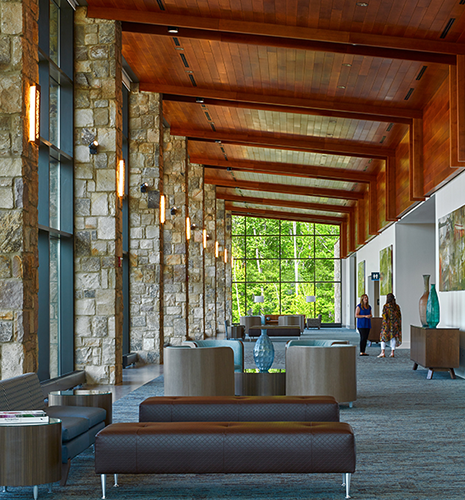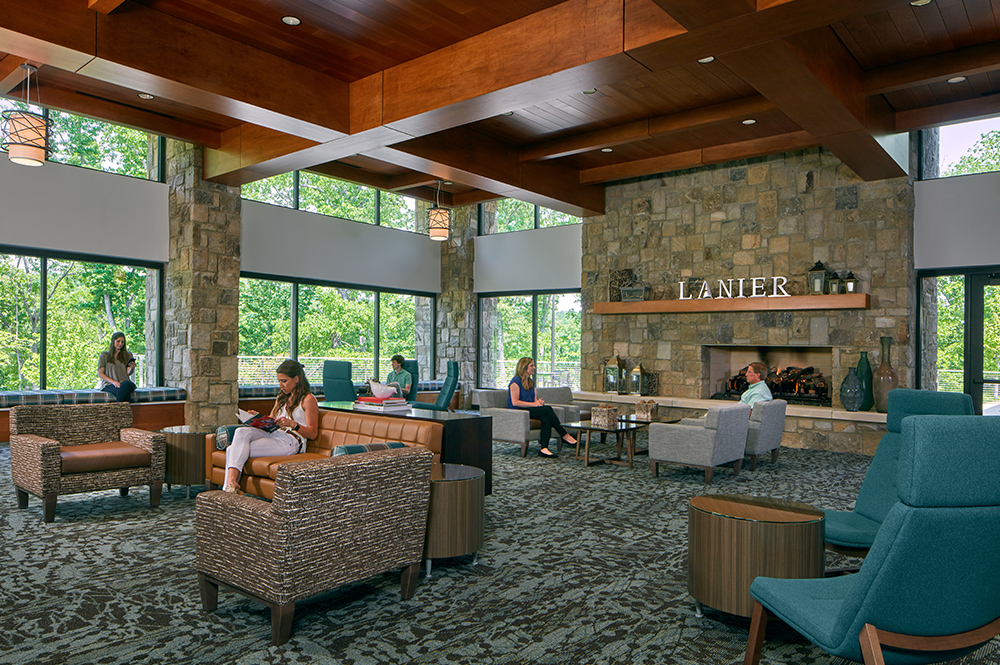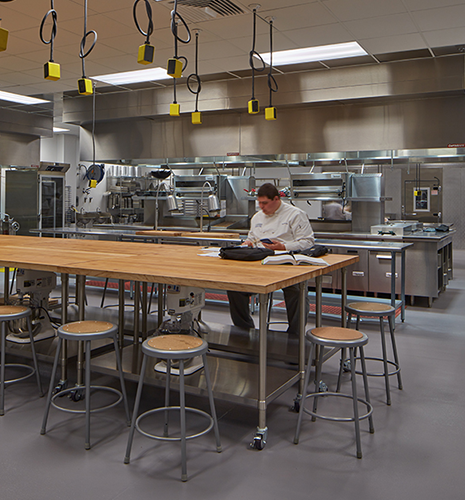Wilbur and Dixie Ramsey Conference Center
Lanier Technical College

Projects > Wilbur and Dixie Ramsey Conference Center
Lanier Technical College
Design Awards:
ACEC Georgia – 2019 Engineering Excellence Awards – Honor Award
AGC – 2019 Build Georgia Award $100M+
CMAA South Atlantic Chapter – 2019 Project Achievement Award $100M
Learning by Design – 2019 Outstanding Project Award
In support of Lanier Technical College’s mission to serve as the foremost workforce development resource in northeast Georgia the new Ramsey Conference Center fosters community engagement, enhances the student life experience on campus, and houses the Hospitality Services and Culinary Arts educational programs. The Conference Center is intended to provide much-needed exposition, conferencing, meeting, and performance space for the regional community.
Utilizing a prominent location on campus the highly efficient facility commands spectacular views of the campus, the adjacent Ramsey Lake, and surrounding foothills of the north Gainesville area. Great care was taken to align building entrances, outdoor terraces, and windows to take advantage of these views.
The building layout includes the campus bookstore accessible to students, faculty, staff, and the visiting public. The primary meeting venue is a large ballroom that is sub-dividable into up to eight (8) smaller meeting rooms. This room can support banquets of over 740 seats or lectures of up to 920 seats and is serviceable by a perimeter service corridor linking the room directly to storage, support, and the catering kitchen. Culinary Arts is supported by a large culinary arts lab and adjacent catering kitchen. The facility also includes two class / breakout rooms, a large lounge with outdoor terrace, large lobby and pre-function spaces, and a hospitality management office suite.
Pond (prime design professional), in association with SSOE, was selected to provide professional design services for the college’s new Gainesville campus. SSOE supported the overall design team by leading the Programming effort for the entire campus, leading the interior design and furnishing, fixture, and equipment (FF&E) efforts for the entire campus, and providing overall design team project management. SSOE also provided full architecture and engineering design services as Architect of Record for the Breeden-Giles Hall Administration Building, the Chris Riley Instructional Building, and the Wilbur and Dixie Ramsey Conference Center.





 Geoffrey H. Radbill Center for College and Life Design
Geoffrey H. Radbill Center for College and Life DesignAutodesk Construction Cloud (ACC) is SSOE’s enterprise-wide project delivery platform. We partner with the Autodesk Product team and have research access. Use of the AI Assistant allows our design teams, owners, and general contractors the ability to query the project specifications for quality, answers, and more rapid responses to RFIs, submittals, or issues.
SSOE has developed a proof-of-concept to use an AI Agent to act as a Master Engineer and Architect trained in SSOE’s processes, best-known-methods, and trainings. Our data structure is being remodeled to enable better use of our proprietary knowledge to train the agent on the ‘SSOE way’.
SSOE is actively piloting AI Chat large language models (LLMs) or copilots that use Natural Language Processing (NLP) to streamline both design and development tasks, transforming how our teams interact with software and each other.
By integrating chat LLM engines into platforms like Revit, we’re enabling users to prompt complex actions using simple, conversational commands. In Revit, this means automating tasks such as modeling elements, cleaning up parameter data, managing annotations and dimensions, and organizing sheets—without writing scripts. These automations and quality prompts can be shared across project teams, accelerating workflows and reducing manual effort.
Similarly, our internal Software Development Community is leveraging GitHub Copilot to expedite coding tasks. Developers can generate and refine code using NLP prompts, tapping into GitHub’s extensive Repo to move faster from concept to implementation.
Together, these tools represent a shift from traditional, expert-driven scripting to intuitive, AI-assisted automation, unlocking new levels of efficiency and scalability across our projects.
We helped our client visualize and optimize façade design for occupant comfort—long before breaking ground through the use of the Autodesk Forma tool. It allows the designer to rapidly experiment with the building’s geometry and façade design to promote sustainability, prioritizing quality of spaces and comfort for end uses, especially in extreme climates (daylighting and microclimate analysis tools) at the project’s exact geographic location, using location-specific environmental data.
Discover how SSOE is using Autodesk Forma to improve sustainability outcomes for industrial projects: SSOE Group: Improving sustainability outcomes for industrial projects with Autodesk Forma.
SSOE is utilizing Microsoft Copilot Edge and M365 to significantly enhance work efficiency and accuracy across various departments. Copilot is accessible to all staff after training. Key areas of application include using it as a writing assistant, for idea generation, document summarization and generation, research assistant, excel assistant, programming code assistant, language translations, product comparison and data analysis. Use of Copilot has become part of the everyday life of SSOE employees who have identified key ways it can help them become more efficient with their daily tasks as well as more accurate in their deliverables.
Today, 100% of SSOE employees have taken the voluntary training and have access to Copilot Edge, achieving early our October 1, 2025 goal.
We found ourselves in need of a more robust tool to enhance resource forecasting and staff assignment capabilities. Instead of waiting for the perfect tool, we’re building it. SSOE’s in-house technology team has developed and piloted a tool that aims to forecast optimal staff mix and duration for new projects against existing workload to better understand capacity and manage resources efficiently. Additionally, the tool will allow teams to identify gaps to optimal staff mix.